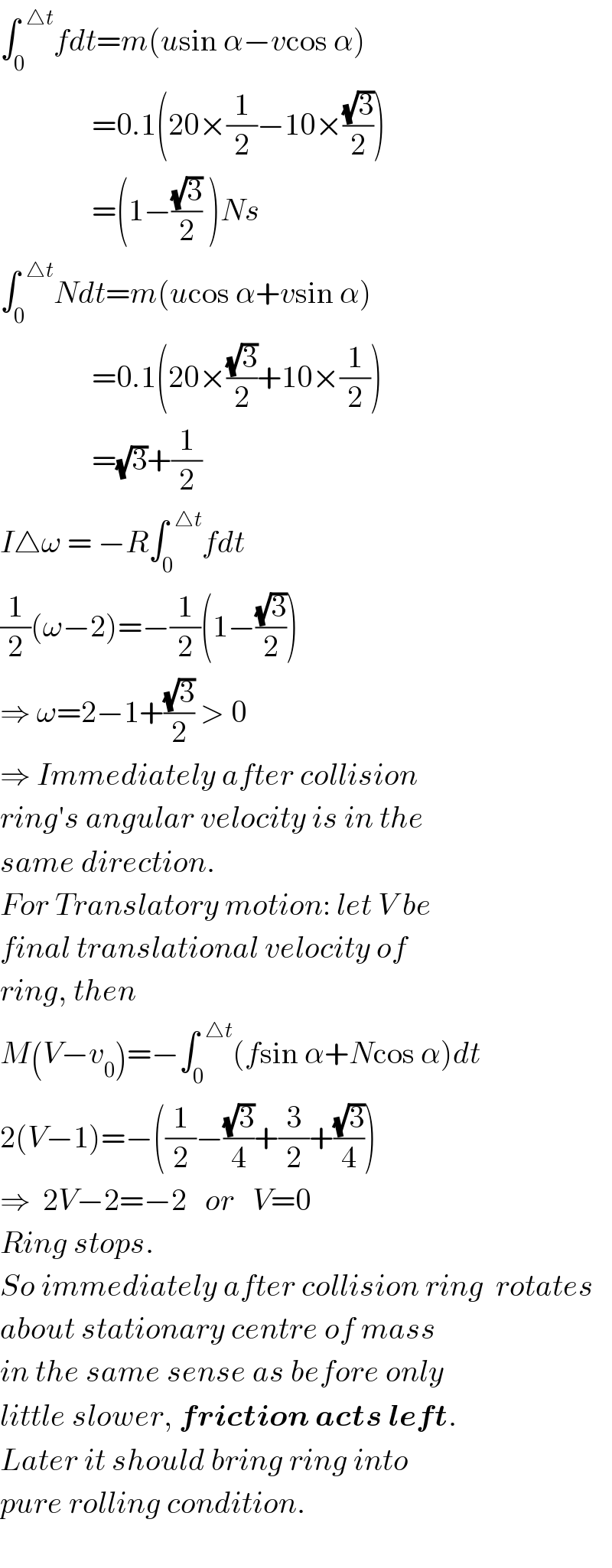
Question Number 22487 by ajfour last updated on 19/Oct/17

Commented by ajfour last updated on 19/Oct/17

$${Q}.\:\mathrm{22473}\:\left({solution}\:\right) \\ $$
Answered by ajfour last updated on 19/Oct/17

$$\int_{\mathrm{0}} ^{\:\:\bigtriangleup{t}} {fdt}={m}\left({u}\mathrm{sin}\:\alpha−{v}\mathrm{cos}\:\alpha\right) \\ $$$$\:\:\:\:\:\:\:\:\:\:\:\:\:\:\:=\mathrm{0}.\mathrm{1}\left(\mathrm{20}×\frac{\mathrm{1}}{\mathrm{2}}−\mathrm{10}×\frac{\sqrt{\mathrm{3}}}{\mathrm{2}}\right) \\ $$$$\:\:\:\:\:\:\:\:\:\:\:\:\:\:\:=\left(\mathrm{1}−\frac{\sqrt{\mathrm{3}}}{\mathrm{2}}\:\right){Ns} \\ $$$$\int_{\mathrm{0}} ^{\:\:\bigtriangleup{t}} {Ndt}={m}\left({u}\mathrm{cos}\:\alpha+{v}\mathrm{sin}\:\alpha\right) \\ $$$$\:\:\:\:\:\:\:\:\:\:\:\:\:\:\:=\mathrm{0}.\mathrm{1}\left(\mathrm{20}×\frac{\sqrt{\mathrm{3}}}{\mathrm{2}}+\mathrm{10}×\frac{\mathrm{1}}{\mathrm{2}}\right) \\ $$$$\:\:\:\:\:\:\:\:\:\:\:\:\:\:\:=\sqrt{\mathrm{3}}+\frac{\mathrm{1}}{\mathrm{2}}\: \\ $$$${I}\bigtriangleup\omega\:=\:−{R}\int_{\mathrm{0}} ^{\:\:\bigtriangleup{t}} {fdt} \\ $$$$\frac{\mathrm{1}}{\mathrm{2}}\left(\omega−\mathrm{2}\right)=−\frac{\mathrm{1}}{\mathrm{2}}\left(\mathrm{1}−\frac{\sqrt{\mathrm{3}}}{\mathrm{2}}\right)\: \\ $$$$\Rightarrow\:\omega=\mathrm{2}−\mathrm{1}+\frac{\sqrt{\mathrm{3}}}{\mathrm{2}}\:>\:\mathrm{0} \\ $$$$\Rightarrow\:{Immediately}\:{after}\:{collision} \\ $$$${ring}'{s}\:{angular}\:{velocity}\:{is}\:{in}\:{the} \\ $$$${same}\:{direction}. \\ $$$${For}\:{Translatory}\:{motion}:\:{let}\:{V}\:{be} \\ $$$${final}\:{translational}\:{velocity}\:{of} \\ $$$${ring},\:{then} \\ $$$${M}\left({V}−{v}_{\mathrm{0}} \right)=−\int_{\mathrm{0}} ^{\:\:\bigtriangleup{t}} \left({f}\mathrm{sin}\:\alpha+{N}\mathrm{cos}\:\alpha\right){dt} \\ $$$$\mathrm{2}\left({V}−\mathrm{1}\right)=−\left(\frac{\mathrm{1}}{\mathrm{2}}−\frac{\sqrt{\mathrm{3}}}{\mathrm{4}}+\frac{\mathrm{3}}{\mathrm{2}}+\frac{\sqrt{\mathrm{3}}}{\mathrm{4}}\right) \\ $$$$\Rightarrow\:\:\mathrm{2}{V}−\mathrm{2}=−\mathrm{2}\:\:\:{or}\:\:\:{V}=\mathrm{0} \\ $$$${Ring}\:{stops}. \\ $$$${So}\:{immediately}\:{after}\:{collision}\:{ring}\:\:{rotates} \\ $$$${about}\:{stationary}\:{centre}\:{of}\:{mass} \\ $$$${in}\:{the}\:{same}\:{sense}\:{as}\:{before}\:{only} \\ $$$${little}\:{slower},\:\boldsymbol{{friction}}\:\boldsymbol{{acts}}\:\boldsymbol{{left}}. \\ $$$${Later}\:{it}\:{should}\:{bring}\:{ring}\:{into} \\ $$$${pure}\:{rolling}\:{condition}. \\ $$$$ \\ $$
Commented by Sahib singh last updated on 19/Oct/17

$${Thank}\:{you}\:{very}\:{much} \\ $$$${sir}. \\ $$$$ \\ $$
